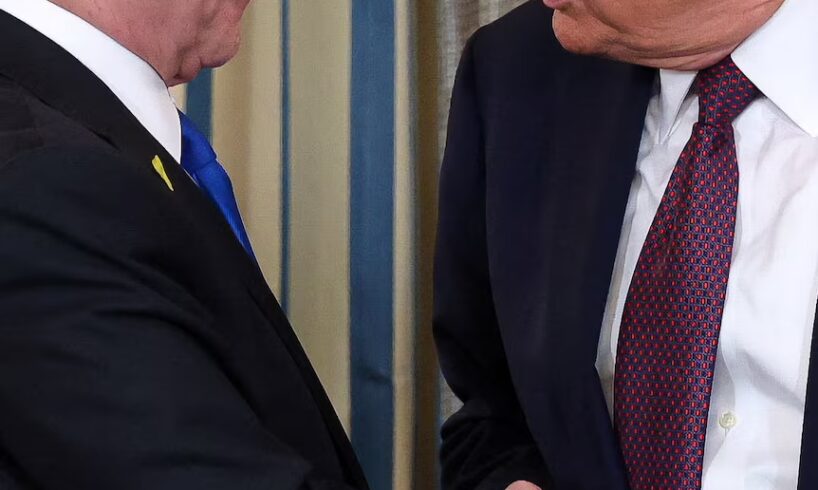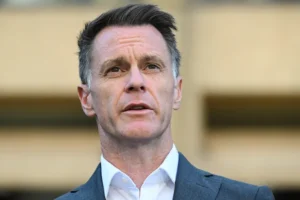
In any negotiation, it’s always the tricky final details that are the hardest to agree on.
That has especially been the case in the long, dismal history of failed Middle East peace deals — where “final status” issues like where borders would be drawn, and the location of a Palestinian capital in East Jerusalem, have tripped up negotiators in the final stretch.
In this case, it’s the reverse situation.
Palestinians walk to their homes in north Gaza as ceasefire begins
Yes, there’s an agreement for a ceasefire, and the release of hostages and prisoners.
But almost everything else appears to have been pushed out to be dealt with later — from the date of a full Israeli withdrawal, to who will govern Gaza afterwards, to an implausible “pathway to Palestinian statehood”.
The last ceasefire between Israel and Hamas fell apart in March, when a second round of negotiations that were supposed to finalise a peace agreement never got underway.
This deal is supposedly far more comprehensive. However, some elements directly contradict Israel’s “red-line” positions.
All of which means there is any number of ways this could all fall over — perhaps within days.
Hamas may not disarm
Palestinian Hamas militants pictured here in February in Khan Younis, Gaza. (Reuters: Hatem Khaled)
Let’s assume the first hurdles are cleared — the return of all remaining hostages in Gaza, in exchange for Palestinian prisoners in Israel.
History suggests that will happen, as it did in stages during the last ceasefire in January, until it collapsed.
Let’s also assume Israel’s military pulls back out of Gaza’s coastal city areas in the first 72 hours, as agreed.
Here, according to Donald Trump’s 20-point plan, is what should happen next — and why it might not:
Hamas fighters to disarm, under the supervision of independent monitors.
It’s hard to overstate how significant it would be for Hamas — a resistance group and listed terrorist organisation — to disarm.
Trump ‘eternal peace’ in Gaza turns into a shaky ceasefire
It has previously said it would only lay down its weapons once a Palestinian state had been established.
In its initial response to the US plan, Hamas did not mention disarming at all.
However, there are reports Hamas has told mediators it may be prepared to give up its missiles, but not its small arms — and even then, only if Donald Trump can guarantee that Israel will not resume fighting.
That’s a big if.
Israeli forces to remain in Gaza: Netanyahu
US President’s Special Envoy Steve Witkoff (left) and White House advisor Jared Kushner (right) with Benjamin Netanyahu. (Supplied)
Last year, Israel repeatedly breached the ceasefire in Lebanon, launching air strikes it said were aimed at stopping Hezbollah from re-establishing its military presence during the truce.
Preventing similar breaches of the Gaza ceasefire deal would also mean relying heavily on Donald Trump’s willingness to restrain Israel — something that for much of his presidency, he has shown little interest in doing.
This part of the deal is looking shaky:
Israel to pull back its military forces to an agreed upon line, and stay there until conditions are met for a complete staged withdrawal.
Donald Trump’s plan clearly states that the demilitarisation of Gaza would be done “under the supervision of independent monitors”.
But on Friday, Israeli Prime Minister Benjamin Netanyahu said Israeli forces would remain in Gaza to pressure Hamas until it disarmed.
“We grapple Hamas. We grapple it all around, ahead of the next stages of the plan, in which Hamas is disarmed and Gaza is demilitarised.
“If this can be achieved the easy way, very well. If not, it will be achieved the hard way,” he said.
Israeli Defense Force (IDF) ground forces during operations throughout the Gaza Strip in July. (Supplied: IDF/X)
In any case, the details of Israel’s withdrawal are extremely vague.
The Trump 20-point plan says the IDF will withdraw “… based on standards, milestones, and time frames linked to demilitarisation that will be agreed upon between the IDF, [the International Stabilisation Force], the guarantors, and the United States, with the objective of a secure Gaza that no longer poses a threat to Israel, Egypt, or its citizens.”
But if those milestones and time frames exist anywhere, they have not been made public.
No consensus on Gaza authority
The road connecting north and south Gaza was crowded in the hours after the ceasefire started. (ABC News)
Eventually, Israel would resume its security presence on the Gaza perimeter, as it has for two decades — and likely keeping control over who, and what, moves in and out of Gaza through the border crossings.
That’s been a major concern of the international community, especially when it comes to restricting the flow of aid and medical supplies.
Would a return to the status quo on border crossings be acceptable? The plan stated:
Gaza to be governed by a temporary committee of Palestinians and international experts to deliver day-to-day public services, overseen by a Board of Peace chaired by Donald Trump — until control can be handed over to a reformed Palestinian Authority.
That’s not going to happen, according to Benjamin Netanyahu — and possibly, also according to Hamas.
Benjamin Netanyahu speaks during a news conference with Donald Trump in Washington in September. (AP: Alex Brandon)
Standing next to Donald Trump at the White House last month, Netanyahu effectively ruled out the Palestinian Authority (PA) having any role in Gaza.
“I appreciate your firm position that the PA could have no role whatsoever in Gaza without undergoing a radical and genuine transformation,” he said.
The catch in the Trump plan is the word “reform”. In order to assume control of Gaza, the PA must enact changes outlined in Trump’s previous 2020 peace plan.
How Israel made so much of Gaza unliveable
Some have already been implemented, or promised. Some — like recognising Israel as a Jewish state — will not be.
“It won’t come as a surprise to you that the vast majority of Israelis have no faith that the PA leopard will change its spots,” Netanyahu said.
“In your 2020 peace plan … you made clear what that transformation requires. It’s not lip service. It’s not checking a box.
“It’s a fundamental, genuine and enduring transformation. And that means ending pay to slay, changing the poisonous textbooks that teach hatred to Jews, to Palestinian children, stopping incitement in the media, ending lawfare against Israel at the [International Criminal Court], the [International Court of Justice], recognising the Jewish state and many, many other reforms.
“But rather than wait for this miraculous transformation, your plan provides a practical and realistic path forward … in which Gaza will be administered neither by Hamas nor the Palestinian Authority, but by those committed to a genuine peace with Israel.”
Israel lists Palestinian prisoners for release
On the other side, Hamas issued a statement on Saturday saying it rejects “any foreign guardianship”.
Once the ceasefire takes effect, US, Qatari, Egyptian and Turkish mediators will attempt to get both sides to agree what Trump called a “strong, durable, and everlasting peace”.
In September, Benjamin Netanyahu stood in a West Bank settlement and repeated his promise that there would never be a Palestinian state.
“We are going to fulfil our promise that there will be no Palestinian state. This place belongs to us,” he said.
“We will safeguard our heritage, our land and our security.”
An “everlasting peace” is widely regarded as only being possible with the establishment of a Palestinian state.
But Israel’s steady political shift to the right means that any government — with or without Benjamin Netanyahu — would find it impossible to allow a Palestinian state and survive in power.
The October 7 atrocity, and the horror of the hostages, has hardened Israelis’ attitudes even further.
There’s also no knowing what impact the long and devastating war has had on a generation of young Palestinians and their attitude toward living in peace with Israel.





